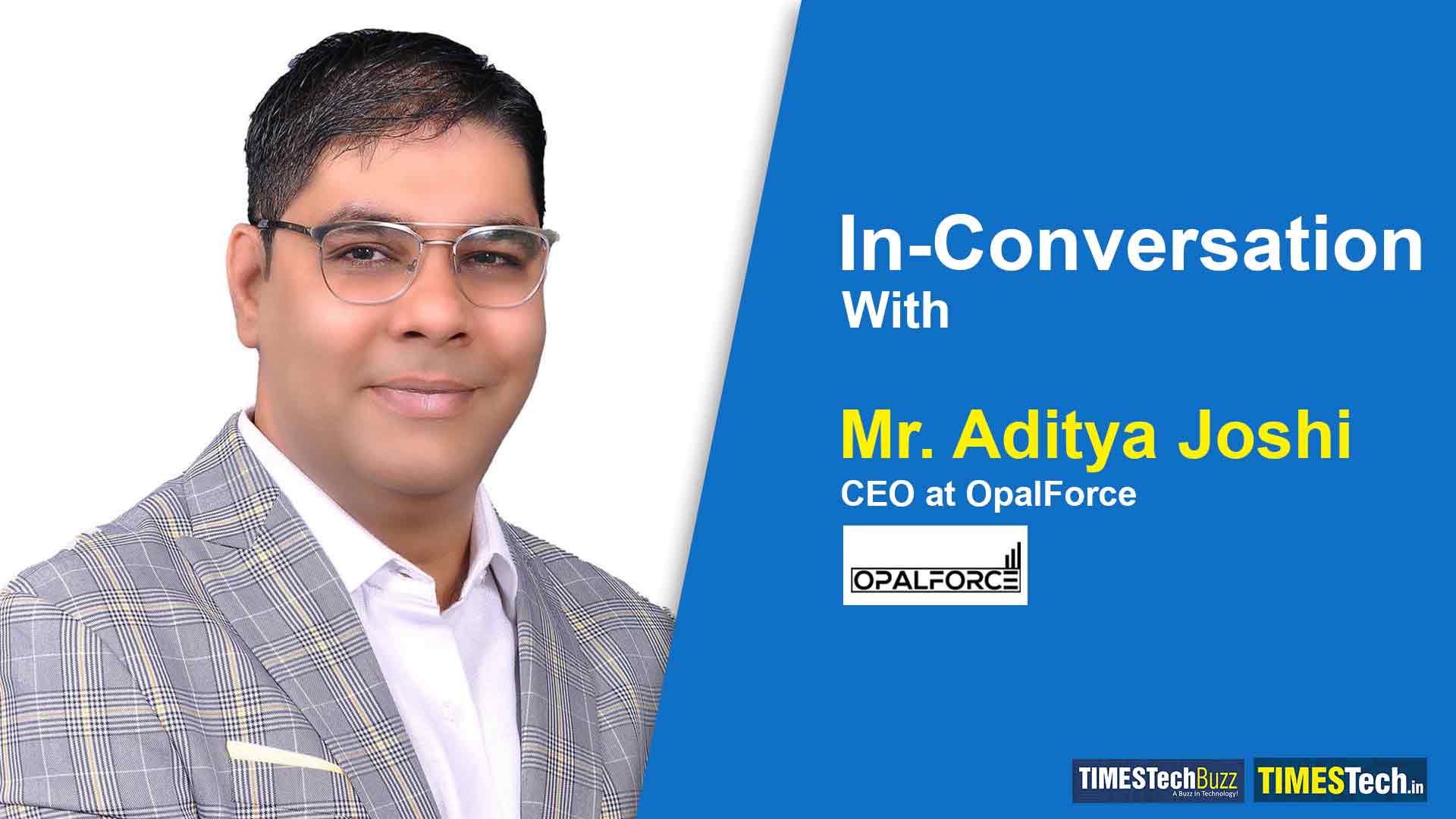In a recent interview with TimesTech, Aditya Joshi, CEO of OpalForce, a prominent player in the semiconductor industry, shared insights into the current state of semiconductor talent and the challenges faced by companies in India while searching for skilled professionals. As the semiconductor landscape continues to evolve, OpalForce is taking proactive measures to address the talent gap, utilizing AI-powered tools, fostering collaborations, and embracing innovative strategies to attract, nurture, and retain top talent while driving innovation within the industry.
Read the full interview here:
TimesTech: OpalForce has been a prominent player in the semiconductor industry. Could you share your insights on the current state of semiconductor talent and the challenges companies are facing in finding skilled professionals in India?
Aditya Joshi: The semiconductor industry in India has been steadily growing and gaining global recognition, attracting multinational companies and becoming a hub for semiconductor design and manufacturing.
India holds a significant semiconductor design talent pool, comprising 20% of global engineers, yet lacks chip manufacturing capabilities. To tap into its potential and address the projected talent gap, India should focus on:
Enhanced Education: Improve electrical engineering and computer science education for chip design.
Engagement Models: Establish early interactions with internal customers for semiconductor solutions.
Innovation Culture: Foster collaboration among academia, industry, and government for innovative solutions.
However, the industry faces challenges in sourcing skilled professionals:
Skill Gap: Finding professionals with specialized skills in chip design, fabrication, testing, and packaging, particularly for advanced technologies, is a challenge.
Education and Training: Many educational institutions’ curricula don’t align with industry needs, emphasizing the need for industry-relevant training programs.
Talent Competition: High demand for skilled professionals leads to competition for hiring, potentially causing salary inflation and retention difficulties.
Rapid Technological Advances: The fast-paced nature of semiconductor advancements necessitates a skilled workforce capable of keeping up with cutting-edge technologies.
Experience Shortage: Due to the industry’s complexity, experienced individuals are in high demand, particularly for leadership roles.
Infrastructure Challenges: While progress has been made, India still faces obstacles in providing advanced manufacturing and testing facilities for the semiconductor industry.
To tackle these issues, collaborative efforts between industry and academia, skill development programs, increased research and development investment, and initiatives to foster innovation and entrepreneurship are being undertaken by both the industry and the government.
TimesTech: AI is transforming various industries, including semiconductors. How is OpalForce utilizing AI in the talent acquisition process to bridge the semiconductor talent gap and identify promising candidates more effectively?
Aditya Joshi: Resume Screening and Matching: AI-powered algorithms can quickly scan and analyze resumes, identifying candidates whose skills and qualifications match the job requirements.
Predictive Analytics: AI can analyze historical data to predict which candidates are most likely to succeed in a particular role based on factors like skills, experience, and cultural fit.
Automated Sourcing: AI can search online platforms, databases, and social media to identify potential candidates who might not have applied directly but possess the desired skills.
Chatbots and Virtual Assistants: AI-powered chatbots can engage with candidates, answer their questions, and guide them through the application process, enhancing the candidate’s experience.
Behavioral Assessments: AI can analyze candidates’ responses to assessments and interviews to predict their suitability for the role based on factors like personality traits and communication skills.
TimesTech: As the semiconductor landscape evolves rapidly, what unique job opportunities and roles are emerging within the industry? How can individuals looking to enter or transition into the semiconductor field best position themselves for success?
Aditya Joshi: The evolving semiconductor landscape is creating several unique job opportunities and roles. To succeed in this dynamic field, individuals can take specific steps:
Emerging Job Opportunities:
- AI Chip Designers: Designing specialized chips for artificial intelligence and machine learning applications.
- Quantum Engineers: Developing quantum computing hardware and algorithms.
- Edge Computing Specialists: Designing chips for edge devices to process data locally.
- Cybersecurity Experts: Ensuring semiconductor devices are secure from cyber threats.
- System-on-Chip (SoC) Architects: Designing integrated solutions for various applications.
- Analog/Mixed-Signal Designers: Crafting chips for analog and digital functions.
- Reliability Engineers: Ensuring long-term functionality and durability of chips.
Positioning for Success:
- Education: Relevant degrees, tech updates.
- Specialization: AI, quantum, edge.
- Skill Development: Chip design tools, languages.
- Experience: Internships, projects, open-source.
- Networking: Attend events, connect.
- Continuous Learning: Stay adaptable.
- Portfolio: Showcase work online.
- Soft Skills: Communication, teamwork.
- Certifications: Chip design, programming.
TimesTech: The semiconductor talent gap is a global concern. Can you elaborate on OpalForce’s strategies to develop and nurture a talent pipeline that aligns with the ever-changing demands of the industry?
Aditya Joshi: OpalForce is a top semiconductor technology talent provider using best AI practices for chip design, manufacturing, and testing. Their strategies to close the talent gap are:
Manufacturing talent: They find, train, and develop candidates from diverse fields and backgrounds for the semiconductor industry. They also offer ongoing learning and development for their talent.
Using AI and technology: They use AI and technology to improve their talent and solutions. They automate and optimize chip design, manufacturing, and testing with AI. They also use AI to analyze data and generate insights.
Offering agile teams: They offer flexible and scalable talent teams for their clients’ needs. They also support their teams with project management, quality assurance, communication, and feedback.
Creating a culture of excellence: They deliver high-quality solutions that satisfy or exceed their clients’ expectations. They also innovate and collaborate to create cutting-edge solutions and address the semiconductor market challenges and opportunities.
TimesTech: Talent readiness is crucial for sustainable growth. How does Opalforce collaborate with educational institutions, training programs, and industry partners to ensure that aspiring semiconductor professionals are equipped with the right skills and knowledge?
Aditya Joshi: OpalForce often collaborate with educational institutions, training programs, and industry partners to ensure a talent pipeline with the right skills and knowledge:
- Curriculum Input: Provide input on curriculum development to align with industry needs and include relevant topics in semiconductor technology.
- Internships and Co-ops: Offer internships or co-ops to students for hands-on experience and exposure to real-world semiconductor projects.
- Guest Lectures and Workshops: Invite industry professionals as guest lecturers or workshop facilitators to bring real-world insights and practical knowledge into the classroom.
- Research Partnerships: Conduct joint research projects with research institutions to enable students to work on cutting-edge technologies and gain valuable experience.
- Training and Skill Development: Provide training programs or workshops for students and recent graduates on technical skills that are in demand in the semiconductor industry.
- Hackathons and Competitions: Sponsor or organize hackathons, competitions, or design challenges that allow students to showcase their skills and creativity in solving semiconductor-related problems.
- Scholarships and Financial Support: Offer scholarships or financial support to students pursuing degrees or research in semiconductor-related fields.
- Industry Advisory Boards: Establish industry advisory boards with representatives from educational institutions, training programs, and industry partners to provide guidance on curriculum and skill development.
- Job Placement and Recruitment: Facilitate job placement and recruitment events with educational institutions to connect graduating students with potential employers in the semiconductor industry.
- Continuous Engagement: Maintain ongoing communication and engagement with educational institutions and training programs to stay updated on industry trends and provide input for curriculum updates.
TimesTech: The future workforce is expected to be more diverse and technologically adept. What steps is OpalForce taking to create an inclusive work environment that welcomes individuals from diverse backgrounds and supports their growth within the semiconductor sector?
Aditya Joshi: Strategies that we often adopt to create an inclusive work environment and support the growth of individuals from diverse backgrounds:
- Diversity Hiring Initiatives: Actively recruit and hire talent from diverse backgrounds by implementing inclusive hiring practices, reaching out to underrepresented groups, and minimizing biases in the hiring process.
- Employee Resource Groups (ERGs): Establish ERGs that provide a platform for employees to connect, share experiences, and collaborate on diversity and inclusion initiatives.
- Mentorship and Sponsorship Programs: Implement mentorship and sponsorship programs to support the professional growth of individuals from diverse backgrounds and ensure they have access to opportunities for advancement.
- Training and Education: Provide diversity and inclusion training for all employees to raise awareness, promote empathy, and foster a more inclusive workplace culture.
- Leadership Development: Offer leadership development programs that focus on individuals from diverse backgrounds, preparing them for leadership roles within the company.
- Flexible Work Arrangements: Provide flexible work arrangements to accommodate different needs and lifestyles, promoting work-life balance and inclusivity.
- Inclusive Policies and Benefits: Review and update company policies and benefits to ensure they are inclusive and address the needs of a diverse workforce.
- Celebrating Diversity: Recognize and celebrate cultural and religious holidays and events, and create opportunities for employees to share their unique perspectives.
- Feedback and Listening Channels: Establish feedback mechanisms that allow employees to share their experiences and suggestions for creating a more inclusive work environment.
- Partnerships and Outreach: Collaborate with external organizations and educational institutions to promote diversity in the talent pipeline and engage with underrepresented groups.
TimesTech: In the context of semiconductor talent, how do you see the intersection of remote work, digital collaboration tools, and the need for hands-on tasks? How is Opalforce adapting to these trends to attract and retain top talent?
Aditya Joshi: OpalForce adapts to remote work, digital tools, and hands-on tasks in the semiconductor talent landscape by:
- Remote Work Flexibility: Offering flexible remote work options to balance work and personal lives and attract a broader range of talent.
- Digital Collaboration Tools: Investing in advanced digital tools to enable seamless communication and virtual collaboration among remote teams.
- Hybrid Work Models: Implementing hybrid work models with clients, allowing remote work part of the time and access to resources and equipment for hands-on tasks when needed.
- Virtual Labs and Simulations: Developing virtual labs and simulations to enable hands-on tasks remotely, enhancing skill development and practical experience.
- Skill Development Programs: Offering online training and skill development programs to enhance knowledge and expertise in semiconductor technologies.
- Remote Onboarding: Establishing a comprehensive remote on-boarding process to integrate new hires into the company culture and workflows.
- Balancing Hands-On and Remote Tasks: Planning projects strategically to balance hands-on tasks with remote work, ensuring effective contribution to both aspects.
- Mentorship and Virtual Learning: Facilitating virtual mentorship programs and learning sessions to provide guidance, support, and skill-sharing among team members.
- Employee Well-being Initiatives: Implementing well-being initiatives to support mental and physical health, creating a positive work environment.
TimesTech: As AI continues to shape industries, it’s also transforming the way companies approach hiring. Could you provide examples of how OpalForce is leveraging AI-powered tools to enhance candidate assessment and match the right talent with the right roles?
Aditya Joshi: OpalForce adapts to remote work, digital tools, and hands-on tasks in the semiconductor talent landscape by:
- Resume Screening and Matching: Use AI to analyze resumes and identify candidates whose skills and qualifications match job requirements. The skilled recruitment team ensure to run the AI engine to evaluate CV by parsing and evaluate the candidate using digital scoring methods.
- Skill Assessment: Use AI platforms to administer skill tests to candidates, objectively evaluating their abilities in semiconductor-related areas.
- Behavioral Analysis: Use AI to analyze candidates’ responses in video interviews, assessing communication skills, problem-solving abilities, and cultural fit.
- Predictive Analytics: Use AI to analyze historical hiring data and identify patterns that predict candidate success in different semiconductor roles.
- NLP: Use NLP algorithms to evaluate candidates’ written communication skills through cover letters, emails, or application responses.
- Chatbots and Virtual Assistants: Deploy AI chatbots to interact with candidates, answer questions, and guide them through the application process, enhancing candidate experience.
- Video Analysis: Use AI tools to analyze non-verbal cues, facial expressions, and tone of voice in video interviews to gain insights into candidates’ emotional intelligence and soft skills.
- Cultural Fit Assessment: Use AI algorithms to analyze candidates’ online presence and social media activity to assess their alignment with the company’s values and culture.
- Candidate Ranking: Use AI to rank candidates based on their qualifications, skills, experience, and potential fit, streamlining the selection process.
- Bias Reduction: Use AI platforms to reduce unconscious bias by focusing on objective criteria, leading to fairer candidate evaluations.
TimesTech: Predicting future workforce trends is pivotal. From OpalForce’s perspective, what skills and competencies are expected to be in high demand within the semiconductor industry in the next 5-10 years, and how can individuals prepare for these changes?
Aditya Joshi: Skills and competencies that are often expected to be in high demand in the industry over the next 5-10 years, based on broader industry trends up to my knowledge cut-off in September 2021:
- AI and Machine Learning Expertise: Skills in developing AI-driven algorithms and optimizing hardware for AI applications.
- Quantum Computing Knowledge: Expertise in quantum hardware, algorithms, and programming.
- Edge Computing Proficiency: Skills in designing energy-efficient, low-latency chips that can process data locally.
- Cybersecurity Skills: Understanding hardware security and developing robust solutions.
- Advanced Packaging Techniques: Knowledge of advanced packaging techniques like 3D integration and chip stacking.
- Analog/Digital Integration: Proficiency in both analogue and digital design for integrated solutions.
- IoT and Connectivity Expertise: Skills in designing chips for IoT devices and wireless communication protocols.
- Materials Science and Nanotechnology: Understanding advanced materials and nanoscale technologies for semiconductor performance.
- Cross-Disciplinary Collaboration: Ability to collaborate effectively across hardware, software, and other fields.
- Adaptability and Continuous Learning: Ability to learn and adapt to new technologies quickly.
TimesTech: With the semiconductor landscape being highly competitive, both for companies and job seekers, what sets OpalForce apart in terms of its approach to talent acquisition, development, and long-term engagement, ultimately driving innovation within the industry?
Aditya Joshi: OpalForce strategies that often adopt to stand out in the competitive semiconductor landscape:
- Holistic Talent Strategy: A comprehensive talent strategy that covers Talent Acquisition, Skill Development, Mentorship, and Career Growth.
- Cutting-Edge Projects: Challenging and innovative projects that push the boundaries of semiconductor technology.
- Professional Growth: Clear pathways for career progression, skill enhancement, and leadership opportunities.
- Cross-Functional Collaboration: Collaboration between departments and external partners for multidisciplinary solutions and breakthroughs.
- Innovation Time: Dedicated time to explore new ideas or work on personal innovation projects.
- Recognition and Rewards: Recognition and rewards for innovative contributions, through incentives, awards, or public acknowledgment.
- External Partnerships: Collaboration with universities, research institutions, and Semiconductor start-ups for fresh ideas, talent, and emerging technologies.
- Investment in Learning: Continuous learning opportunities, through in-house training and external resources.















